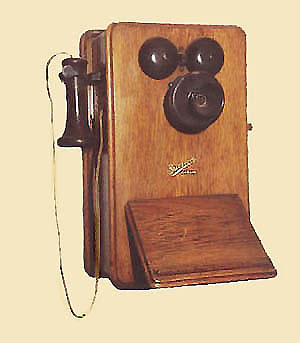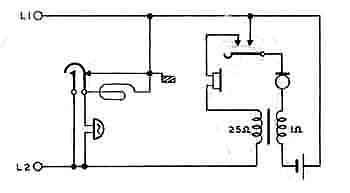 Type 35MW Type 35MW
In Australia this phone is known as the "British Ericsson".
The term covers the Model N2500 and the many varieties that descended from it.
The principal models are:
35MW: Early Ericsson transmitter and decorative mount, as shown at left.
135MW: This was upgraded to the Solid Back transmitter around 1920, then
to the bakelite Inset transmitter
235MWH: Renovated to a handset version.
765AWH: Auto wall phone with generator signalling for auto party lines.
There were many varieties within this range as the phones were modified
and upgraded throughout their long life.
The phone was introduced for testing before World War One. I have seen one
with a service card beginning at 1916, but serious quantity purchases did
not commence until the end of the War, when the Beeston factory returned to
peacetime production. First deliveries were made in 1919-1920. The earliest
deliveries had the Ericsson drum transmitter mounted on their decorative pressed
steel mount.

135MW
This was soon changed to the newer Solid Back transmitter on a simpler folded
steel bracket. The metalwork was finished in"antique bronze", an
oxidised brass effect. The phone proved reliable and popular and many thousands
were installed. A later upgrade saw the transmitter changed to the bakelite
Inset transmitter, still on the folded steel mount. These phones were still
imported in quantity, but the supply of the 300 magneto bakelite series with
its more popular handset style gradually cut into demand.
This phone has been refurbished and the nmetal parts sprayed with black enamel.
This was a standard prectice for the APO.
 Some of
the phones arrived with a wooden plug covering a dial cutout in the front
of the case. Some phones were converted to automatic working, but the practice
does not appear to have been general policy. The PMG's stated policy was that
customers would be provided with a new model phone if the service was converted
to automatic. With the introduction of bakelite phones the conversion of this
model was never necessary, and most phones fitted with dials are later private
conversions. Some of
the phones arrived with a wooden plug covering a dial cutout in the front
of the case. Some phones were converted to automatic working, but the practice
does not appear to have been general policy. The PMG's stated policy was that
customers would be provided with a new model phone if the service was converted
to automatic. With the introduction of bakelite phones the conversion of this
model was never necessary, and most phones fitted with dials are later private
conversions.
The 765MW, however, was used in auto areas on party lines where the magneto
signalling was still needed. There were few of these.
This example is in oak instead of the more common walnut. It shows the Inset
transmitter added to the older mount, and the plug in the dial hole.
 In a final attempt to refurbish the large quantities of wooden phones in stock,
the APO decided to convert the phone to handset operation. There were some
variations within each model. In Sydney, the "How To Call" instruction
plate (used to cover the old transmitter holes) was mounted horizontally.
Victorian phones usually had the notice mounted vertically. Writing slopes
often had to be replaced, and there are different patterns and timbers used.
Each phone was fitted with a note clip at the top of the writing slope (not
shown on this refurbished phone).
In a final attempt to refurbish the large quantities of wooden phones in stock,
the APO decided to convert the phone to handset operation. There were some
variations within each model. In Sydney, the "How To Call" instruction
plate (used to cover the old transmitter holes) was mounted horizontally.
Victorian phones usually had the notice mounted vertically. Writing slopes
often had to be replaced, and there are different patterns and timbers used.
Each phone was fitted with a note clip at the top of the writing slope (not
shown on this refurbished phone).
A similar refurbishment was
sometimes carried out in New Zealand, but the old transmitter holes were simply
filled with wooden plugs.
 135MWH circuit 135MWH circuit
 To
Type 37 Series To
Type 37 Series  To
Type 33MW To
Type 33MW  To
QuickFind To
QuickFind  If you have reached this page through a Search Engine, this will take you to the front page of the website If you have reached this page through a Search Engine, this will take you to the front page of the website
|